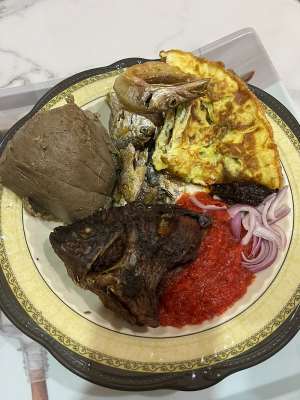
The Ga-Komi, or Otim, is the Ga-Dangme word for Kenkey, a corn-based staple food of the natives of the Greater Accra Region, the capital of Ghana.
While the Ga-Komi is wrapped in corn husks and contains some salt in its preparations, the Fantes also have their version of Kenkey, which is known as Fante Dorkunu and is often prepared without salt and wrapped in plantain leaves.
Kenkey, which is mostly served with some fried fish, shrimp, and eggs, among others, goes well with various types of grounded pepper (kpakposhito, akweley waabii, and shitogbii), as well as a dash of shitodin or kenamshito (black pepper, which Ghanaians refer to as shito).
Its versatility also allows it to be taken with soup and stew; one can also decide to blend it into mashke (mashed kenkey) mixed with some sugar, groundnut, milk, and ice for a cooling effect.
Corn food is so important to the Ga-Dangmes that, even in naming a child, a corn wine is put in the mouth with the statement that, “abele akԑ lԑo bi,” to wit, we feed children with corn.
However, in recent times, several Kenkey eaters have been forced to drop their love for corn based Kenkey due to some health effects and discomfort, such as heartburn, they experience after eating the food prepared from fermented corn dough.
To ease such discomfort and still get the satisfaction that Kenkey gives, some are turning to a newfound love, Millet-Kenkey, which they said does not trigger reactions in their digestive system.
Ms Nora Naa Atwei Mensah, the leader of Norettes Cookery, is one of the few people meeting the needs of kenkey lovers through the provision of Millet-Kenkey.
Ms Mensah, who is an assistant civic educator at the National Commission for Civic Education (NCCE), disclosed in an interview with the Ghana News Agency (GNA) that she identified Millet-Kenkey by accident.
According to her, her first encounter with the food was in 2020, when she attended an exhibition and saw it on display.
She added that, as curious as she was, she bought some balls to check if the taste and feel were the same as her Ga-Komi, which at the time was triggering heartburn in her.
“Apart from the colour, I realised that everything about it was just like our kenkey. My curiosity took me to YouTube to check if they did not add any corn,” she said.
Ms Mensah, who before this did not sell kenkey, bought two 'olonka' tins of millet and went through the process of soaking, milling, and making a dough from it just as it is done with the corn.
She indicated that after going through the needed fermentation process, she prepared part of the dough into 'aflata' (partially cooked like banku), after which uncooked millet dough is mixed with it and wrapped in corn husk for steam cooking for hours until soft.
According to her, she displayed this on her social media platform, which attracted the attention of friends who then ordered for some, adding that this has generated a business in which she prepares over 200 balls of millet-Kenkey fortnightly for clients who pre-order.
She further said that sometimes she gets orders weekly for social functions, as many have come to embrace the nutritional benefits of the millet-kenkey.
She said some research she did into the health benefits of millet, which is a gluten-free grain, revealed that it contains fibre, calories, carbohydrates, protein, fat, phosphorous, iron, and folate, among others, making it ideal for lowering blood sugar and cholesterol.
On how to preserve the millet kenkey, she said it must be put in a bowl without a cover at room temperature and must be consumed within four days, adding that it could, however, be put in the fridge and warmed later for longer days.
GNA




 Court dismisses Serwaa Amihere case against Henry Fitz, two others
Court dismisses Serwaa Amihere case against Henry Fitz, two others
 Stolen BRVs: Bi-partisan parliamentary probe non-negotiable — Dr. Omane Boamah
Stolen BRVs: Bi-partisan parliamentary probe non-negotiable — Dr. Omane Boamah
 Bawumia begins regional campaign tour on Monday
Bawumia begins regional campaign tour on Monday
 With great urgency backed by verifiable data, facts and figures dismiss COCOBOD,...
With great urgency backed by verifiable data, facts and figures dismiss COCOBOD,...
 EC’s statement on obsolete BVDs discovery “lies, half-truths, pure fantasies” – ...
EC’s statement on obsolete BVDs discovery “lies, half-truths, pure fantasies” – ...
 Nalerigu court impound vehicles of DCE, Director of Chereponi district for owing...
Nalerigu court impound vehicles of DCE, Director of Chereponi district for owing...
 Cop, 7 others grabbed over $523,000 Gold Scam
Cop, 7 others grabbed over $523,000 Gold Scam
 Akufo-Addo’s driver wins Dadekotopon NPP Parliamentary Primary
Akufo-Addo’s driver wins Dadekotopon NPP Parliamentary Primary
 Investigate, jail persons liable for GRA-SML contract – Manasseh
Investigate, jail persons liable for GRA-SML contract – Manasseh
 Lawyer wins Akan NPP Parliamentary Candidate primary
Lawyer wins Akan NPP Parliamentary Candidate primary
